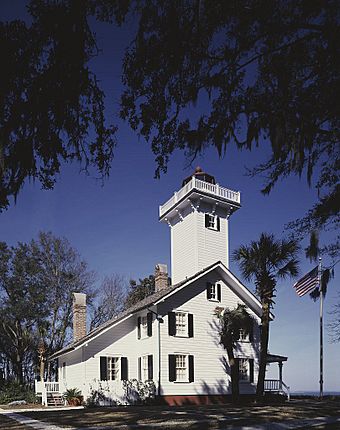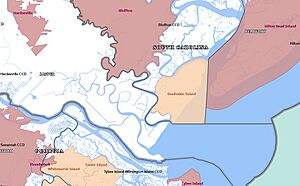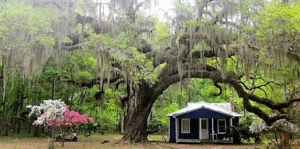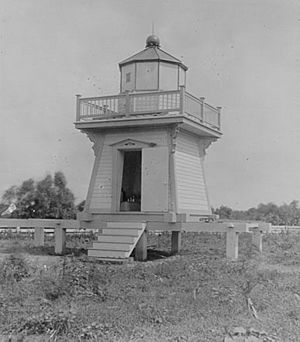Daufuskie Island facts for kids
Quick facts for kids |
|
|
Daufuskie Island Historic District
|
|

Haig Point Rear Range Light
|
|
| Nearest city | Hilton Head, South Carolina |
|---|---|
| Built | 1728 |
| Architectural style | Greek Revival |
| NRHP reference No. | 82003831 |
| Added to NRHP | June 2, 1982 |
Daufuskie Island is a special place located between Hilton Head Island and Savannah. It's the southernmost island in South Carolina where people live, part of the Sea Islands. The island is about 5 miles (8 km) long and almost 2.5 miles (4.0 km) wide, covering an area of about 8 square miles (21 km2). It has over 3 miles (5 km) of beautiful beaches and is surrounded by Calibogue Sound, the Intracoastal Waterway, and the Atlantic Ocean. In 2020, about 557 people lived there.
You can only reach Daufuskie Island by ferry or barge, and it has a small full-time population of just over 400 people. The island is home to nature preserves, private communities, resorts, and historic Gullah houses. You can also find many art galleries and learn about its rich history. Daufuskie was named a historic district on the National Register of Historic Places because of its important Gullah and Civil War history. The island is also the setting for Pat Conroy's famous book, The Water Is Wide. This book shares his experiences teaching on Daufuskie in the late 1960s.
Contents
- A Look Back: Daufuskie Island's History
- What Industries Thrive on Daufuskie?
- Exploring Daufuskie Island's Areas
- Who Lives on Daufuskie Island?
- Island Life: Culture and Governance
- Learning on Daufuskie: Education
- Getting Around Daufuskie: Transportation
- Nature's Wonders: Flora and Fauna
- Daufuskie's Weather: Climate
- Famous People from Daufuskie
- Daufuskie in Books, Songs, and TV
- See also
A Look Back: Daufuskie Island's History
Daufuskie Island has been home to people for thousands of years. We know this from old piles of oyster shells found there, which also contain pieces of ancient pottery. Before Europeans arrived, many Native American tribes lived in the Lowcountry area and on the islands. These tribes spoke languages from the Muskogean family. The name Daufuskie comes from the Muscogee language and means "sharp feather," describing the island's unique shape.
Early Explorers and Settlers
Around 1523, Spanish explorers sailed along the southeastern coast of North America, looking for places to settle. By 1565, the Spanish had settled in St. Augustine, Florida, and began moving up the coast to create more colonies. At the same time in the 1500s, the French also tried to set up colonies in the South Carolina Lowcountry. By the mid-1600s, the English started exploring the southern coast. Wealthy planters from the Caribbean helped fund trips to South Carolina. Captain William Hilton and Robert Sandford both sailed to Port Royal Sound and the nearby areas. In July 1666, Sandford entered Calibogue Sound, which is between Hilton Head and Daufuskie.
During these early explorations, Spanish settlers brought their special Iberian horses to the southeastern coast. Today, the descendants of these horses are called "Carolina Marsh Tacky" horses. These strong, smart horses are very good at living in the swampy and marshy lowcountry. You can still find some of these rare horses on Daufuskie Island today.
Conflicts and New Beginnings
In 1684, Spanish soldiers asked Native American warriors to help them fight Scottish settlers in Port Royal. This was the start of a difficult history where Native Americans became involved in European settlement conflicts. The different cultures eventually clashed in the Yamasee War. This war included three fierce battles on the southwestern shore of Daufuskie Island between 1715 and 1717. This area is still called Bloody Point because of these battles.
The search for religious freedom brought two European families to Daufuskie Island. One was the great-grandson of a French Huguenot named David Mongin. The other was the daughter of an Italian Prince, Filippo de Martinangelo, who escaped the Inquisition. The stories of these two founding families are closely linked throughout their long history. Both families became powerful plantation owners on the island.
Revolution, Cotton, and Ships
The American Revolution caused people in the lowcountry to have divided loyalties. Daufuskie was even nicknamed "Little Bermuda" during the Revolution because many residents supported the British Loyalists. After the Revolution, Daufuskie thrived thanks to the introduction of world-famous sea island cotton. This type of cotton was highly valued by European factories. Sea island cotton was known for its long, fine, and strong fibers, better than other long-staple cottons. During this time of strong economic growth, several large plantation mansions were built.
The demand for wood to build American wooden tall ships led to a need for timber from live oak trees. These trees were plentiful on Daufuskie. This type of hardwood, found only on the southeastern coast, was prized by shipbuilders. It was strong, resisted rot, and had naturally curved branches. Daufuskie was a key place for the "live oaking" trade, which was very important for the US Navy. Shipbuilders came to Daufuskie to cut down the oaks, shape them, and drag the pieces by oxen to coastal docks. The famous USS Constitution—known as "Old Ironsides"—was built using live oak.
Before the Civil War, there were eleven plantations on Daufuskie. Large homes were built on some of these lands, like Oakley Hall at Bloody Point, Melrose, and Haig Point. The mansion at Haig Point was special because it was built from tabby. It was the largest tabby house ever built in coastal South Carolina.
Tabby is a type of concrete brought to the southeast by early Spanish settlers. It's made by burning oyster shells to create lime, then mixing it with water, sand, ash, and broken oyster shells. Today, three of the best-preserved slave dwellings with tabby walls in Beaufort County can still be seen at Haig Point.
Civil War and Gullah Culture
Early in the Civil War, Union forces took control of the islands in the Beaufort area. Union troops on Daufuskie helped with the attack on Fort Pulaski, which protected the entrance to the Savannah River. Because of this Union presence, white plantation owners fled, leaving their property and enslaved people behind. After the war, Daufuskie's remote location allowed the Gullah culture to survive and thrive for many generations.
The Gullah language is a lasting legacy from the enslaved people and later laborers who stayed on the island after the plantations closed. The lowcountry was isolated until the mid-20th century. Daufuskie's extreme isolation created a perfect environment for the Gullah people's language and customs to remain very well preserved. Their local dialect is strongly influenced by West African languages and old English. Daufuskie is right in the middle of the Gullah/Geechee Cultural Heritage Corridor.
Oysters and Modern Times
After the Civil War, farming, mining, and timber industries started up again in Beaufort County and the lowcountry. This activity made the waterways around Daufuskie very busy, as the island was in a key spot between Port Royal and Savannah. Because of the increased ship traffic, navigation aids like lighthouses became necessary. In 1873, the Haig Point Range Lights were built on the island's northern end. Then, in 1883, the Bloody Point Range Lights were built to help ships approaching the Savannah River entrance.
From the 1880s, the oyster industry on Daufuskie grew very quickly. By the early 1900s, the island had a population of 2,000-3,000 people. Most of them worked in this profitable shellfish business. The flat coastline, saltmarsh areas, and natural oyster reefs, along with a long spawning season, made the waters around Daufuskie perfect for growing many large, tasty oysters. Daufuskie oysters were famous even in places like Bar Harbor and New York. It's even said that the Tsar of Russia preferred Daufuskie oysters!
Eventually, in the 1950s, pollution caused the oyster beds to close, and the island's economy suffered. Electricity came to the island in 1953, and telephones in 1972. However, with few job opportunities, the population shrank to less than a hundred people. This left behind a rich Gullah history. In the 1980s, developers began planning to turn Daufuskie Island into a place for homes and resorts. This led to the creation of planned communities like Bloody Point, Melrose, Haig Point, and Oakridge. Despite this growth, the island's historic district has been kept untouched to protect the Gullah culture. Today, the entire island is on the National Register of Historic Places.
What Industries Thrive on Daufuskie?
Daufuskie Island's shoreline and tides are perfect for oysters to grow for a long time. On the island, oysters grow in clusters, not just one by one. The Native Americans living on the island valued the many oysters found there. Huge piles of shucked oyster shells on the island show how much the native people used oysters. They ate the oysters and used the shells to make tools, fertilizer, and tabby.
The oyster industry started on Daufuskie Island in the 1880s. An Italian immigrant named Luigi Paolo Maggioni rented oyster beds and opened a place to shuck raw oysters. Later, in 1893, he opened the L.P. Maggioni and Company Oyster Factory. This factory harvested, shucked, steamed, and canned oysters to send to Savannah. The company's success brought other oyster businesses to the island. Several shucking shacks and factories stayed on the island even after the L.P. Maggioni Company moved to Savannah, Georgia.
The oyster industry did very well, and people as far away as Bar Harbor and New York thought Daufuskie Island oysters were a special treat. "Daufuski" brand oysters, with their unique Indian chief label, were shipped all over the world. It's even reported that Tsar Nicolas II of Russia enjoyed them. The Great Depression in the 1930s and World War II caused the oyster industry to decline, as many people left the island for better jobs. The industry faced more problems when pollution from the Savannah River in the 1950s contaminated the island's oyster beds. New laws about wages also increased costs, leading the cannery to close after the spring season in 1986. Luckily, small local shops still sell oysters on the island today.
Exploring Daufuskie Island's Areas
The island is currently divided into five main parts.
To the northeast is the Haig Point Club. This is a private club owned by its members, with about 150 people living there all year and over 225 homes.
South of Haig Point was the Melrose Resort and a community of homes. Further south on the eastern side of the island is Oak Ridge, a small undeveloped community by the ocean. After that is Bloody Point, which is a semi-private community with homes.
As of April 2019, Melrose Resort is still in disrepair. The person who used to own it faced issues for using resort money for their own expenses.
The western part of the island is not officially part of a town. About 100 people live here in different types of homes, from small cabins to waterfront houses with private docks. This section of the island was officially recognized as a historic district by the government in the early 1980s. A study by the Savannah College of Art and Design found that the island has great examples of Gullah homes that haven't been changed. Descendants of the Gullah people still live in this area on land they have owned since just after the Civil War.
The Historic District is also known for its artisan shops, unique restaurants, and one coffee shop. The coffee shop is located in the Mary Fields School, where author Pat Conroy once taught. This area also has lots of wildlife and a historic church. Most of the Historic District has old, winding dirt roads lined with Live Oaks. Many of these roads, like School Road, Benjie's Point, Prospect Road, Bryant Road, and Pappy's Landing, look very much the same as they did over a hundred years ago.
In 2007, the local Daufuskie Island Fire and Rescue Department counted only 429 full-time residents on the entire island. Famous rock musician John Mellencamp built a house on the island and uses it as a quiet getaway.
Who Lives on Daufuskie Island?
|
Daufuskie Island
|
|
|---|---|
 |
|
| Country | |
| State | |
| County | Beaufort |
| Area | |
| • Total | 15.75 sq mi (40.78 km2) |
| • Land | 9.81 sq mi (25.41 km2) |
| • Water | 5.94 sq mi (15.38 km2) |
| Elevation | 10 ft (3 m) |
| Population
(2020)
|
|
| • Total | 557 |
| • Density | 56.78/sq mi (21.92/km2) |
| Time zone | UTC-5 (Eastern (EST)) |
| • Summer (DST) | UTC-4 (EDT) |
| FIPS code | 45-18610 |
| GNIS feature ID | 2812931 |
Daufuskie Island is an area in Beaufort County, South Carolina, where people live but it's not an official town. It's also a census-designated place, which means the government counts its population for statistics. It covers the population of Daufuskie Island, which is the southernmost island in South Carolina where people live. It's also a historic district listed on the National Register of Historic Places. In the 2020 census, its population was 557 people.
| Historical population | |||
|---|---|---|---|
| Census | Pop. | %± | |
| 2020 | 557 | — | |
| U.S. Decennial Census 2020 |
|||
In 2020, the population of Daufuskie Island was 557 people. Most residents (88.05%) were White. A smaller number were Black or African American (2.51%), Asian (0.90%), or identified as Mixed Race/Multi-Racial (3.77%). About 3.41% of the population was Hispanic or Latino.
Island Life: Culture and Governance
The First Union African Baptist Church is on Daufuskie Island. It's the oldest building on the island and is still used as a church today.
Daufuskie Island has two historic lighthouses. The Bloody Point Lighthouse was built in 1883, and the Haig Point Lighthouse was built ten years earlier.
The island is part of Beaufort County, South Carolina. It has an elected council called the Daufuskie Island Council. This council acts as the official voice for Daufuskie Island when dealing with the county and other groups.
For a long time, Daufuskie had a tradition of managing itself. The Beaufort County Sheriff's office only came for emergencies. But because more tourists started visiting in 2018, the island asked for more police presence to keep an eye on visitors. Now, with more police around, both residents and visitors are getting more tickets and warnings for things like golf cart registrations and open containers.
Learning on Daufuskie: Education
Daufuskie Island School is a public school in the Beaufort County School District. It was built in 1997 and is a modern building with two classrooms, a lunchroom, and a library. Students are in multi-grade classrooms, meaning younger kids (pre-K through 2nd grade) are together, and older kids (3rd through 5th grade) are together. Usually, there are about 15-18 students each year. The school gets a lot of support from the community and many volunteers on the island.
Students in grades 6 through 12 travel to Hilton Head Middle School and Hilton Head High School. On Daufuskie, these students take a small school bus to the ferry. Once they reach Hilton Head, a county school bus picks them up and takes them to their schools. The whole trip takes about an hour and ten minutes each morning and afternoon. Students often do their homework or nap during the boat ride.
Getting Around Daufuskie: Transportation
No bridges connect Daufuskie Island to mainland South Carolina. This means you can only get to the island by boat. A public ferry makes several trips each day between Buckingham Landing in the Bluffton area and Melrose Landing on Daufuskie.
Beaufort County provides a special ferry that helps transport residents. The Haig Point Club also has its own private ferry service. There are also several private companies that offer 25-30 minute water taxi services to the island. Residents of the clubs and some other islanders use golf carts and bicycles to travel around the island. However, some regular cars and trucks are also used.
Nature's Wonders: Flora and Fauna
The Daufuskie Island Conservancy is one of several local groups that work to protect the island's ecosystem, plants, animals, and overall quality of life.
Daufuskie Island has a wide variety of nature and animal life. One interesting animal that lives on the island is the fox squirrel. The bald eagle is also one of the creatures you can find on the island.
Daufuskie's Weather: Climate
Daufuskie Island has a humid subtropical climate. This means it has hot, humid summers and cool, refreshing winters.
| Climate data for Daufuskie Island, South Carolina | |||||||||||||
|---|---|---|---|---|---|---|---|---|---|---|---|---|---|
| Month | Jan | Feb | Mar | Apr | May | Jun | Jul | Aug | Sep | Oct | Nov | Dec | Year |
| Mean daily maximum °F (°C) | 60 (16) |
63 (17) |
69 (21) |
76 (24) |
82 (28) |
87 (31) |
89 (32) |
88 (31) |
84 (29) |
77 (25) |
69 (21) |
62 (17) |
76 (24) |
| Mean daily minimum °F (°C) | 39 (4) |
41 (5) |
47 (8) |
54 (12) |
62 (17) |
69 (21) |
72 (22) |
72 (22) |
68 (20) |
57 (14) |
48 (9) |
41 (5) |
56 (13) |
| Average precipitation inches (mm) | 3.8 (97) |
3.5 (89) |
3.9 (99) |
3.0 (76) |
3.8 (97) |
5.1 (130) |
6.3 (160) |
7.8 (200) |
5.9 (150) |
3.5 (89) |
2.5 (64) |
2.9 (74) |
52.1 (1,320) |
| Source: Weatherbase | |||||||||||||
Famous People from Daufuskie
Daufuskie in Books, Songs, and TV
The Jimmy Buffett song "Prince of Tides" (from his 1988 album Hot Water) talks about how Daufuskie was developed and how the Gullah culture changed.
Pat Conroy's 1972 book The Water Is Wide is set on Daufuskie, which he called Yamacraw Island in the book. The book tells about Conroy's experiences teaching on the island in 1969. The book won him a humanitarian award and an Anisfield-Wolf Book Award. The book was made into a movie called Conrack in 1974, starring Jon Voight. It was also made into a TV movie in 2006, also called The Water Is Wide, starring Jeff Hephner.
One episode of the National Geographic Channel TV show Diggers (Season 2, Episode 10; 2013) showed professional treasure hunters Tim Saylor and George "KG" Wyant visiting Daufuskie to look for pirate gold.
The March 2014 issue of Architectural Digest magazine featured the Daufuskie part-time home of singer John Mellencamp.
Travel + Leisure magazine named Marshside Mama's restaurant, located at the County Landing on Daufuskie, as one of the "Ten Best Beach Bars" in America.
The Travel Channel show Bizarre Foods America had a segment with Daufuskie native Sallie Ann Robinson. This was in an episode (Season 1, Episode 8; 2012) that focused on Lowcountry and Gullah food and culture.
See also
 In Spanish: Daufuskie Island para niños
In Spanish: Daufuskie Island para niños







